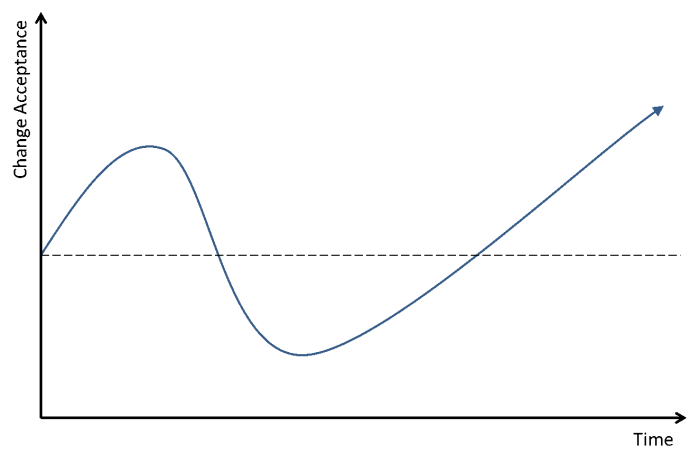Managing change is something that we all have to do. No matter how much we try and avoid it, change will always occur in life. It doesn’t matter if we are an individual or an organisation – change will find us. We can either choose to be proactive and embrace change, or we can wait until it is thrust upon us. Waiting makes us have to react to the change – sometimes in ways that aren’t fully thought through. Being proactive is the better, long-term, option.
When wishing to gain greater control over the change process, a good place to start is to understand the change acceptance curve. The change acceptance curve plots how an individual’s acceptance of a change both rises and falls during the process of going through that change.
While there are difference images for the change acceptance curve I like using a very simple view that I have used many times over, both personally and professionally. You will find much more detailed curves after a very brief internet search. The curve itself was originally modelled from work performed by Elisabeth Kubler-Ross back in the 1960s after research into the grieving process.

This curve shows clearly that somebodies acceptance of a change is not a fixed value – it will naturally rise and fall as they go through the change in question. This is very useful for a number of different reasons:
- It reassures people that even if they are no longer accepting of a change it does not mean that it is a bad change
- It encourages people to continue through the change process, as they will start to feel better about it
- It helps people understand why they might suddenly have lost faith in a change
- It reassures people that the doubts that they are feeling will subside
- It prevents too many people questioning if the change was correct
- It lets people know that how they have reacted to a change is perfectly normal
Managing change, and limiting the risk of change, is a large part of my interactions with clients. I have found that the better I am able to get them to understand the change process, the more they trust me and the easier it has been to get the required change fully implemented. When companies do not understand this acceptance curve, quite often changes are cancelled when too many of the employees have hit the bottom of the curve. Believe me, it can sometimes feel that they have fallen off a cliff.
Often I wait to introduce this image to a customer. Showing it to them too early in the change process will mean little to them. Waiting for the enthusiasm to wane and for some employees hit the bottom has a much more powerful effect. I see heads nodding as I present it, and often people start talking openly about where they see themselves on the curve. I remember one customer was so taken by the concept that they printed out a large copy of the curve and got people to add their names to the curve. This helped them track how key project members were handling the change – if people did not progress along the curve they were given more support.
While we cannot remove this change acceptance what we can do is to reduce the time it takes to travel along it. As individuals we are all responsible for our own change acceptance curve. Through increasing our emotional intelligence we are able to shorten the time it takes to travel alone the curve.
This means that we can then start making positive use of the change that we went through. Companies that successfully deal with change are ones that understand how this curve works. They understand the people side to change, and work with their employees to shorten the acceptance period.
If you would like to read a little more about my own person journey with change then please follow the link below:
Change is one of the inevitable facts of life so it a good idea to develop methods to handle it. Being proactive means that you start out by driving change, instead of it driving you. Accepting that your personal acceptance of a change will fall during the process arms you with knowledge that you can control this process. Developing your emotional intelligence gives you the strength and tools to do this.
